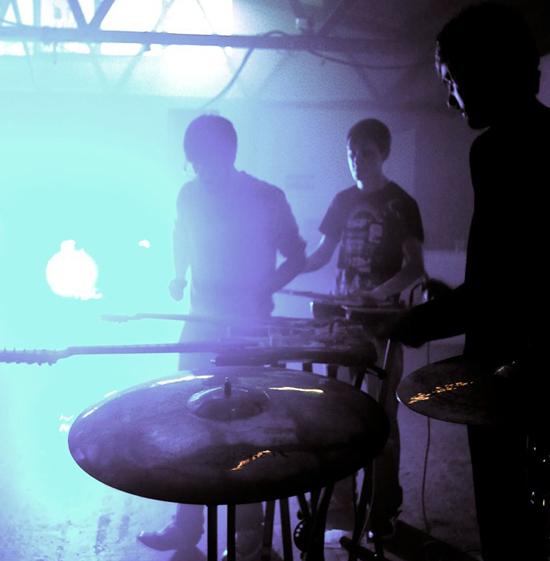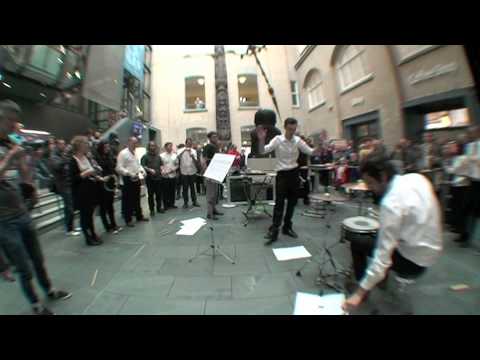At the end of September some 2000 people (myself included) gathered at Liverpool Psych Fest, to indulge in what was in reality a relatively niche line-up of psych rock. A couple of weeks beforehand, American minimalist composer Rhys Chatham performed a sell-out concert at Liverpool Cathedral with a hundred-strong guitar orchestra in tow. The days of critics convincingly being able to link musicians to their city’s scene are on the way out in these times of all-access, but, living in a place where many of the locally on-trend acts at least seem to have half-an-eye on goings on either in London or on the pages of Pitchfork, it’s a refreshing slap in the face to witness a music community that, though smaller, seems so much more open-minded to the truly leftfield and experimental.
Ex-Easter Island Head are one such act to have emerged as a striking shade in Merseyside’s multi-coloured tapestry. Formed as a duo in 2009 out of a desire to move away from their early, more conventional rock paths, they’ve since released three pieces of work on Low Point Records: last year’s Mallet Guitars One and – a couple of months ago – Mallet Guitars Two and live recording Music For Moai Hava, as well as expanding into a quartet. Their contents are skillfully balanced between methodical precision and emotional resonance, their warmth coming from – as their titles indicate – the use of mallets on the bodies and strings of horizontally-laid guitars. These primary percussive hits provide drive to their work, while the natural echoes that they produce create secondary layers that wrap themselves around that rhythmic core. The result is a listen that’s dynamic, rich and fluid despite the modesty of its parts.
As well as citing influences like Chatham and Glenn Branca, Ex-Easter Island Head’s Benjamin D. Duvall gives credit to his surrounding Liverpool; a place he says possesses promoters sensitive to ways in which to present what some might consider more "serious" music in an audience-friendly manner. He also points out the mutual support between local acts irrespective of genre (Ex-Easter Island Head are also part of the stylistically nomadic a.P.A.t.T Orchestra which, from Duvall’s description of ever-changing members and range of abilities, brings to mind Cornelius Cardew’s famous Scratch Orchestra which for a time in the 70s featured Brian Eno).
Yet so much more of Duvall and his group’s creative ambition comes from within, from wanting to get rid of the hierarchy of a traditional band set-up, to a repeated desire to challenge themselves within defined limitations. The latter is an oft-repeated manifesto among musicians; the difference with Ex-Easter Island Head comes in their refusal to let it affect the ambition and scope of the output it gives expression to.
When interviewed by The Wire magazine earlier this year you spoke of Ex-Easter Island Head coming about because you wanted to stop playing in "regular bands". Was there a particular reason or disillusionment in that more orthodox set up?
Benjamin Duvall: There wasn’t a definitive moment of disillusionment with the ‘regular’ way of doing things, but I really liked the idea, from a performance point of view, of not having familiar elements on stage; presenting the audience with something visibly quite different and striking, and seeing how people would engage with it and where we could take it depending on that.
My reference to ‘regular bands’ was maybe a bit precious and too general, but what I meant by that was moving away from ‘fixed’ line-ups of guitarist/bassist/drummer with one person reduced to just one role. For me it’s much more exciting to have performers who can change roles and instrumentation depending on the piece; it opens up the writing process a lot more. It’s also an attempt to try and remove the sense of hierarchy in a typical ‘band’ line-up – in a way we’re all the drummer and we’re all the guitarist, which at the very least gives it an air of unpredictability!
You also mentioned "downplaying the rock element" in your music…
BD: I knew that I personally didn’t want us to use distortion, as it had become something of a lazy creative solution in my regular guitar playing. By removing it and deliberately only using clean guitars you’re forced to find other elements to play around with, likewise using partial bits of drum kit or removing the bass guitar entirely. Rhys Chatham is a huge influence on us and his angle initially was melding a compositional approach to minimalism with the more spontaneous and indeed, rocking, aspects of rock; there’s a self-consciousness on our part to do it the other way round – we’re coming from a rock background and trying to embrace the rigour and process of ‘composed’ music.
That said, we had the time of our lives writing for and performing with twelve generously loud guitarists and full drum kit as part of WEYA Festival in Nottingham in September, so we’re not done with rocking just yet!
Ex-Easter Island Head’s work to date is steeped with a minimalist aesthetic. Where does the attraction of working within such limitations lie for you?
BD: It makes for a good way of focusing your writing and can be an interesting challenge when you’ve got purposefully limited materials to work with. A lot of the early minimalist works – Reich’s Phase Patterns or Music for Pieces of Wood for example – are so interesting because they make a virtue out of how few resources you can use and still make music that has this strong emotional pull. I like the balance between these very methodical, disciplined rhythms and musical processes, and the ambiguously beautiful/melancholic music that comes out of it.
Feature continues below image

That was something I was going to bring up; there’s a great life and a subtle sense of warmth to your latest release, Mallet Guitars Two, but how difficult was it for you to not become so immersed in precision that you ended up feeling overly technical?
BD: I think that some of the life in our music actually comes from a lack of technicality in certain places; there are some sections, particularly with the more defined aspects of our sound such as the malleting, where a locked in mechanical sort of feel is crucial, but then in other parts it can afford to sound more human and have a certain swung imperfection. We’re always thinking about the dynamic/emotional arc of a piece, even if it’s only expressed in very ambiguous terms – with the extended techniques we use, the swapping roles of the performers and the preference for simple materials, there’s an aim to consciously avoid technicality for technicality’s sake. A lot of our rhythmic parts come about through a simple idea being pushed until it starts to feel like it’s at the right kind of tempo, has got the right kind of resonance to it, and then it gets a more technical structure worked into it. You have to remember, too, that for the most part we’re still learning how to play the guitar as a percussion instrument, which definitely gives it a bit of a just-hanging-in-there liveliness in some places!
Tell me a little bit about the creative process that you went through specifically for Mallet Guitars Two. You’ve spoken of working within limitations, but in comparison to Mallet Guitars One it does sound like there’s more going on; what changed between the two albums?
BD: It was quite organic really. Most obviously we expanded from a duo so that we could play around with more sounds and layers, whilst keeping the mallet guitars as the main instrument driving things forward. We were living with Jake and Nick who creatively were a really good fit so they came on board, and we worked on Mallet Guitars Two as a quartet for about 10 months before recording it. Much of the piece came about through group interaction and playing live, where we built up little cues and melodies to signal changes, and lengthening or shortening sections depending on how it felt as we progressed between performances. The improvisational nature of these shows helped us develop new techniques, as well increasing our understanding of how our set-up worked. We remained conscious of keeping relatively limited in our materials and tried not fall back on comfortable habits and dynamics.
The overtone-y drone of the guitars tends to be quite high pitched so we settled on other bits of percussion that best complimented those textures: singing bowls, malleted cymbals, claves and the like, and these in turn suggested certain moods and tempos. Additionally some of the new techniques and preparations we were using – moveable bolts under the strings which create this almost vocal-like chorusing sound – had very distinctive sounds, so a marginally more melodic and less stark approach seemed appropriate. Generally, I think that we approached Mallet Guitars Two with a lot more of a group feel, as we’d established an aesthetic with the first piece that acted as a guideline for individual interpretation.
Music for Moai Hava
As a companion piece you have Music For Moai Hava, a live recording of a show you did in September last year at the World Museum in Liverpool, around an 800 year-old statue from Easter Island itself.
BD: Yeah, we had a 27-piece ensemble of hugely varied instruments and abilities at our disposal.
That straight away enforces quite a different approach again then!
BD: Well we decided it’d be more interesting to just lose all the individual orchestral instruments, strip it down to mallet guitars and drums, and have the players performing simple rhythms on bamboo sticks, handclaps and singing simple vocal tones against a drone. That allowed us to level the playing field in terms of abilities, created a more communal feel and also forced us into trying to make music with these very different and distinctive textures, which means you have to approach what you’re doing in a more considered way.
The fact that we were able to take the musicians and ourselves outside of our comfort zones and impose a distinctive set of sounds for the price of £5 worth of bamboo is, I think, quite a good illustration of how closely linked the practical and the philosophical aspects of writing and playing this type of music are!
What personal release do you get from your music?
BD: I take joy engaging an audience with something that’s hopefully a little bit out of the ordinary. Also I enjoy the physicality of the experimenting aspect of our setup. Because we’re not using any effects, there’s lots of physically messing round with guitars and other instruments which is just fun, really! With the sort of music we like to play as well there’s that locked groove, hypnotic feel that you’re striving for with certain parts and big, enveloping drones. When you manage to nail that in the right space with good sound and a good audience, you can really get lost in it – a bit of a cliché I know, but for good reason!
Mallet Guitars Two/Music For Moai Hava is out now on Low Point Records. For more information on Ex-Easter Island Head, click here to visit their website.



